Today’s History Friday column is another in a series focusing on an almost unknown series of military documents from World War II (WW2) called “The Reports of the Pacific Warfare Board,” and specifically Pacific Warfare Board (PWB) Reports #42 Pershing, PWB #76 Future Armament and Employment of Main Armament Flamethrower Tanks, and Pacific Warfare Technical Reports (PWTR) 2 & 3.
These reports, like most of the PWB reports, had been classified for decades and only now, thanks to the cratering costs USB flash drives and increasing quality of digital cameras, has it become possible for the interested hobbyist or blogger to access and write about these reports from the formally hard to use National Archives. While the US Marine Corps histories make clear how they were going to arm their tank battalions, the same is not true of the US Army Tank battalions and much in the way of myth, and little fact, has filled the void. Today’s column seeks to fill in and correct the official narrative of the cancelled by A-bombings Invasion of Japan.
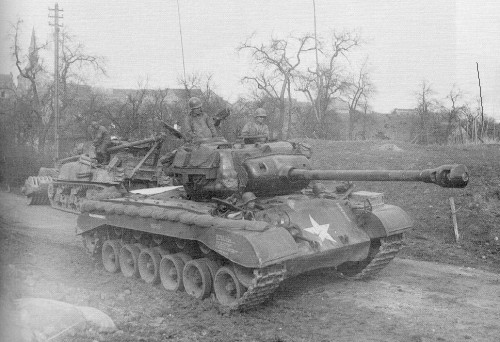
TANK BATTALION FORCE POSTURE AUGUST 1945
There were 14 independent US Army tank battalions in the Pacific in August 1945 with three more due to arrive in September 1945. One of these tank battalions, the 713th on Okinawa, was a ‘provisional’ flame tank unit with 54 flame tanks and three gun tanks in three companies of 19 radial engine M4 Shermans and an additional headquarters element with three M4 gun tanks and an assault platoon of six Ford engine M4A3(105) with HVSS (Horizontal Volute Suspension System) 24-inch wide track suspensions. It would remain a special flame tank unit for Operation Downfall, but was too shot up to participate in the invasion of Kyushu.
While the 713th wasn’t going into Kyushu, nine of the 16 other US Army tank battalions and three Marine Corps Tank battalions were to invade Japan in the November 1945, in the first half of the “Operation Downfall” strategic invasion plan. Those 17 US Army tank battalions were to be joined by six more US Army tank battalions in two Armored Divisions scheduled for the 2nd half of Operation Downfall — the March 1946 Operation Coronet invasion of the Tokyo plains on Honshu.
The standard Pacific area US Army tank battalion in MacArthur’s SWPA (South West Pacific Area) theater prior to V-E Day had three companies of 18 radial engine Shermans armed with 75mm guns (17) and 105mm (1 tank) guns, a single company of 17 each, 37mm gun armed, M5A1 Stuart light tanks plus a battalion headquarters unit with three 75mm gun tanks and a separate “Assault gun” platoon that was to be equipped with 105mm gun armed Shermans. Often shortages of the 105mm gun armed radial engine M4 or M4A1 Sherman lead to their replacement with “Limited standard” or “Substitute Standard” 75mm howitzer armed, M5 Stuart tank based, M8 assault guns; the M7 “Priest” self-propelled guns; or 76mm armed M-10 tank destroyers. A few lucky US Army tank battalions in the SWPA and the US Navy’s Central Pacific Drive had the 75mm armed M4A3 with the more powerful Ford gasoline engine and narrow 16-inch track VVSS (Vertical Volute Suspension System) suspension. In multiple planned invasions of Japan, this situation was going to change radically.
PERSHINGS IN THE STANDARD NARRATIVE
The best of the technical resource books on American tanks in WW2 come from author R.P. Hunnicutt. Neither his ultimate resource books on the M26 Pershing and the M4 Sherman tank say very much regards the invasion of Japan. Reflecting Hunnicutt’s lack of access to the classified Operation Downfall and PWB files at the time he wrote those books, plus the US Army Ordnance Department’s overwhelming focus on the War in Europe in its armored vehicle technical reports.
The best of the standard histories for the invasion of Japan is the 1999 “DOWNFALL: The End of The Imperial Japanese Empire” by Richard Frank. A footnote in Frank’s book states that said in July 1945 orders directly from General Marshall were cut to send 125 M26 Pershings to equip the 767th Tank Btn. in Hawaii and the 706th Tank Btn, then in Luzon, for the Nov 1945 Operation Olympic invasion.
The 767th tank battalion would get three companies of M26, a company of M24 Chaffee light tanks, 10 more POA-CWS-H5 flame tanks and would be with the 98th Infantry Division. The 6th Army’s Field Order 74 and the 98th Division Occupation report had the 98th ID playing the role of floating fire brigade to support and of the three Corps landing on X-day. (See 6th Army landing map)
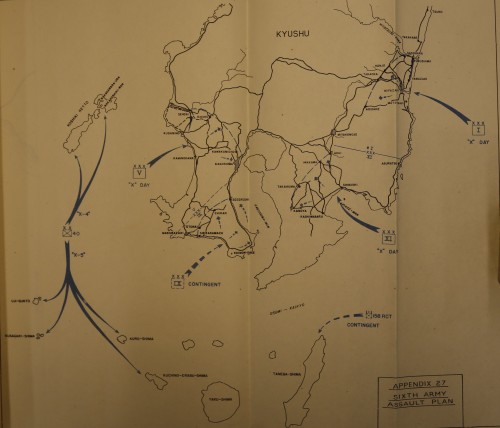
The 706th tank battalion would get four companies of 17 each M26 Pershings (71 total) and no light tanks, ten of the Hawaii built POA-CWS-H5 flamethrowers mounted in M4A3 tanks and, according to FO 74, it would be 6th Army troops at Ariake Wan (IX Corps area) which was the 6th Army’s main effort on Kyushu. Both Battalions would get M4A3(105) HVSS in lieu of the 105mm armed M45 Pershing variant in the assault gun platoons and as medium tank company howitzer tanks.
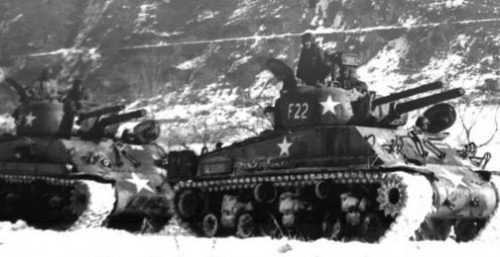
BEYOND THE STANDARD NARRATIVE
At this point the “Standard Narrative” suggests that only seven of 28 medium tank companies Olympic, in only two tank battalions, would be in Pershings. For the remaining 21 medium tank companies in seven battalions, something like the previous 75mm gun armed standard SWPA and Central Pacific Army tank battalions would have been used in invading Japan. What Alternatewars.com researcher Ryan Crierie and I found recently in the Pacific Warfare Board message traffic says something very different. See 14 July 1945 message photo below:
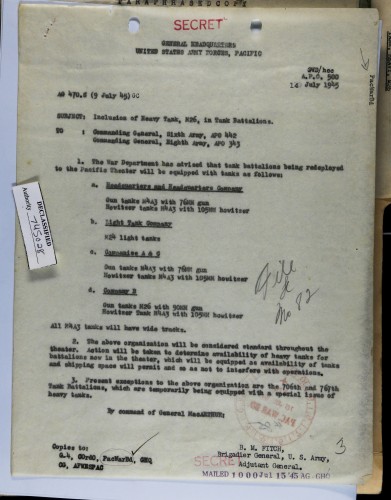
The message states that the new table of organization and equipment for 20 of the 23 for US Army tank battalions for the two “Downfall” plan invasions of Japan — Olympic and Coronet — were to be as follows:
Two Comp. (17 ea) M4A3 (76) HVSS with one M4A3(105) HVSS howitzer tank
One Comp.(17 ea). M26 Pershing with one M4A3(105) HVSS howitzer tank
One Comp (17 Ea) M24 Chaffee
Three ea. M4A3(105mm) HVSS for assault gun platoon plus three M4A3 (76) HVSS battalion HQ tanks
Plus 10 ea M5-4 Flame tanks in M4A3 in two provisional platoons of five flame tanks.
This battalion organization was optimized for infantry support over a wide range of terrain rather than logistical considerations. Each battalion would have three main gun ammunition types (75mm, 76mm and 90mm), a minimum of 2-3 engines (count the higher number if you count the Pershing engine as different from the M4A3 and it was slightly so) 3-4 if using radial engine M4A1 Sherman based M5-4 flame tanks. They would also have a minimum of three different tracks for light tanks, medium gun tanks and medium flame tanks. The M4A1 based flame tank had narrow VVSS suspension with suspension extension kits to allow two sets of double end pin connector track grousers. These grousers or “duck-bill” connectors increased the width of the tracks to 23 inches.
THE GREAT FLAME TANK SHORTAGE
The major problem with that 14 July 1945 plan boiled down to a flame tank shortage. For reasons of US Army procurement politics, the US Army’s Chemical Warfare Service did not receive enough of the right kind of tanks in time to fulfill that organizational outline. And while maverick Chemical Warfare Service officer Col George Unmacht had his special flame tank production unit producing 72 of his coaxial POA-CWS-H5 flamethrower tanks, it still was not enough. The US Army tank battalions supporting the I Corp and IX Corps (two each, four total), another tank battalion supporting the 81st Infantry Division of the XI Corps, and the sixth tank battalion split between the 40th Infantry Division and the 158th Regimental Combat Team would have to share 40 M5-4 flame tanks based on M4A1 tanks. That worked out to a single platoon of five flame tanks per battalion. And so short was MacArthur of personnel, the troops to man these flame tanks would come from SWPA theater tank destroyer battalions not involved in the landing!
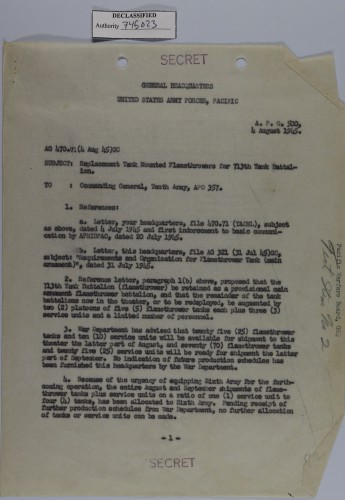
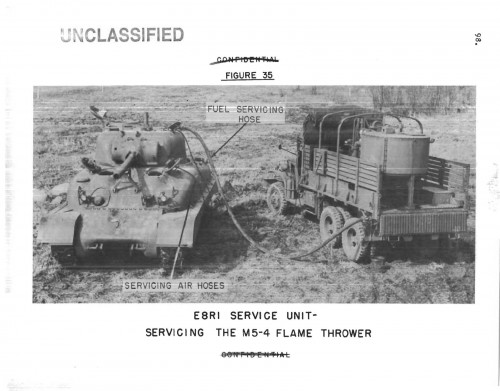
Those six tank battalions and plus an additional tank battalion in 6th Army Operation Olympic reserve supporting the 11th Airborne Division, were to be brought up to a two platoon flame tank strength while Operation Olympic was being executed.
THE OTHER TANK SHORTAGE — PERSHINGS AND M4A3
The other issue that turned up after the July 1945 Standard tank battalion letter was that neither enough of the M26 Pershings nor the Ford engined M4A3 Shermans armed with 76mm guns would arrive in time to reequip Philippine based independent tank battalions in time. Only the three tank battalions arriving in September 1945, all green units who had never seen combat, would have the standard battalion amount of M26 and M4A3 tanks. General Krueger, 6th Army commander, placed them one each in the I Corp, XI Corps and his 11th Airborne Division 6th Army reserve. Photos in R.P. Hunnicutt’s ultimate resource book on the Sherman tank, “Sherman: A History of the American Medium Tank” show a mix of 75mm gun armed M4A3 and M4A1 Shermans in Philippine tank depots in the Summer of 1945. Replacement tanks ordered months before the fall of German in May 1945 and only just arrived by August…and the basis of the old narrative myths about what tanks would have been used to invade Japan.
THE NEW NARRATIVE…ARRIVING
Thanks to the arrival of new digital camera and storage technology, we can see a new historical narrative of the cancelled by A-bomb invasion of Japan emerge.
We can see how the myths of the Pacific Army liking 75mm gun Sherman tanks over other American tanks were created.
And we know know that 10 of the 28 medium tank companies that were going to land in the cancelled Operation Olympic landing (36%), eventually growing to 14 of 28 (50%) by the end of the Olympic, were going to be M26 Pershings.
If only the M 26 had been chosen in 1943. The casualty rate in armored units in Normandy was 600%. They were still using M 4s in Korea !
Mike K,
You need to go read the unpublished Ordnance Branch history at the link below —
The Chieftain’s Hatch: Pershing, Pt2
The Chieftain continues with his look at the development history of the M26 Pershing.
http://worldoftanks.com/en/news/pc-browser/21/The_Chieftains_Hatch_Pershing_2/
“For Part 2 of the Pershing development overview, I’m going to hand the keyboard over to some poor un-named sod in the Ordnance Branch in about 1946 whose job it was to type out Ordnance’s after-action report for the war. One part of this AAR was “Ordnance’s interactions with other agencies”, and for the section on ‘dealing with Army Ground Forces’, they chose to use the T26 development process as an example. I thus copy below, again without comment (I’ll save the analysis for a future part), with the caveat that the below is purely from Ordnance’s perspective. Over to you, aforementioned poor, un-named sod”
Devers was interested until he was assigned to the invasion of southern France, after which his influence was lost.
General Devers pressed on with his advocacy for the T26, going over McNair’s head to General George Marshall, and on 16 Dec 1943, Marshall overruled McNair and authorized the production of 250 T26E1 tanks. Then, in late December 1943, Devers was transferred to the Mediterranean, where he eventually led the invasion of Southern France with the 6th Army Group. In his absence, further attempts were made to derail the T26 program, but continued support from Generals Marshall and Eisenhower kept the production order alive. Testing and production of the T26E1 proceeded slowly, however,
What might have been:
A Panther tank on the street in the front of Cologne Cathedral was laying in wait for enemy tanks. Two M4A4 Sherman were supporting infantry and came up on the same street as the Panther. They ended up stopping just before the Cathedral because of rubble in the street and didn’t see the enemy Panther. The lead Sherman was knocked out, killing 3 of the 5 crew. A T26E3 was in the next street over and was called over to engage the Panther. What happened next was described by the T26E3 gunner Cpl. Clarence Smoyer: “We were told to just move into the intersection far enough to fire into the side of the enemy tank, which had its gun facing up the other street (where the Sherman had been destroyed). However, as we entered the intersection, our driver had his periscope turned toward the Panther and saw their gun turning to meet us. When I turned our turret, I was looking into the Panther’s gun tube; so instead of stopping and becoming an easy target, our driver kept going through the intersection, so I fired a round and hit the enemy tank. The Panther was dispatched and burned for 3 days after the duel, with 2 of the crew surviving.”[44] The action was recorded by a Signal Corps cameraman Tec.Sgt Jim Bates.[45][46]
It was neither Marshall nor Ike that saved the Pershing, it was Undersecretary of War Robert E. Patterson who over ruled McNair.
This is from the link I posted —
More evidence of disagreement between the Ordnance Department and AGF concerning the value of the T26 tank is given in a February 1944 conversation between General Barnes and Colonel M. K. Barroll, an Ordnance officer serving with the General staff. Colonel Barroll reported that he had “heard they (presumably AGF) want to put a lot of armor on the last of the M4A3s off the line and was afraid the main idea is to buck the heavy (T26) job. General Barnes asked Colonel Barroll to “watch” the situation.
Apparently no action was being taken by higher authority to increase the number of heavy tanks under procurement because by 28 February 1944 General Barnes was discussing the preparation of a letter to Headquarters Army Service Forces, for the signature of General Campbell, asking whether or not the War Department desired heavily armored tanks and, if so, at what rate of production. It was General Barnes’ opinion that further production of M4 tanks was a waste of government funds. No such letter was ever sent, although General Banes continued upset over the situation, two days later telling General William A. Borden, another Ordnance officer on duty with the General Starr, that he was in favor of informing higher authority that the Ordnance Department would assume no further responsibility for the probable lack of properly armored and properly gunned tanks for operations of late 1944 and early 1945.
In the following month, however, AGF opposition to larger production of the T26 was overridden and production of 6,000 heavy tanks (including 45 both T25 and T26 models) was informally authorized. A break in the deadlock between Ordnance and AGF was foreshadowed 5 April 1944 when Robert E. Patterson, Undersecretary of War, telephoned General Barnes to tell him that Lt Gen William S. Knudsen, War Department production director, had been talking about the new tanks. Mr. Patterson expressed interest in the vehicle and said he would like to see the new tanks produced in 1944 and inquired as to what should be done to bring about that end. General Barnes suggested that Mr. Patterson talk to General Somervell about getting a production order released. The need for production of the larger number of heavy tanks was made known to the Ordnance Department within a week. General Barnes told his Executive Officer, Colonel S. B. Ritchie, that the large order had come as a result of a reversalof AGF position with respect to heavy tanks. Army Ground Forces, however, said that the production authorization had been increased by the War Department over AGF objections.
Marshall and his men, which McNair was, have much to answer for.
Note — there was a clean up of typos and the addition of a flame tank supply situation document photo.
Trent – You have probably discussed this elsewhere, and I have missed it.
Why did officials oppose developing the Pershing? These were not stupid people, and they should have learned, if not from our allies, at least from our experience in North Africa with the Tiger, that we needed a heavier tank, with a much more powerful gun.
I assume they must have had some reasons for opposing the Pershing. What were those reasons?
(As I understand it, the British were responsible for the Sherman Firefly upgrade, which had a better chance in encounters with the Panther. Again, why didn’t our leaders come to the same conclusion that the British did?
According to Wikipedia, the Firefly development also faced official disapproval, but it got done, anyway.)
Jim Miller,
People are still arguing that.
The short story revolves around two names. General McNair is one who is in the standard narratives.
The other is someone who was relatively air brushed out from US Army institutional histories, Undersecretary of War, Judge Robert Patterson.
McNair like a large number of US Army officers felt that the armored advocates were going to make a different armored corps service like the pilots with the air corps. McNair’s vision of “Tanks don’t destroy tanks, tank destroyers do” was as much an organizational gambit as a fighting doctrine.
His resistance to the Pershing should be seen in that light.
OTOH, McNair was a manpower efficiency expert who was absolutely needed to get the US Army through the war. The US Army of 1942 had 67 ground divisions which had the same manpower of the 89 divisions on late 1944 thanks to him.
Undersecretary of War, Judge Robert Patterson intervened to over rule McNair on the Pershing — as you can see at the posted link — where as the standard narrative institutional histories are silent on that intervention.
After the Army killed the Sherman tank program in June 1945 — which should also bee seen as an extension of the anti-separate armor corps institutional imperitive — Patterson again intervened in the Flame tank shortage and lit a fire under Army Service Force chief General Sommerville to get rebuilt M4A3 gun tanks converted to Flame tanks for MacArthur.
while the German Panther and Tiger tanks were pretty awesome, being able to win in a fight against most things,
the Japanese never had tanks of any great merit.
The IJA mostly had light tanks which weren’t going to be of much good against a Sherman tank and they were just getting around to a decent medium
tank the Type 3, but, they never made more then 300 and with relatively poor tank tactics and lack of air power, they weren’t going to make much effect.
it would seem to support an invasion of the Home islands, we would have been better off with light tanks to screen marine amphib ops and lots of mobile
high velocity guns like the German 88 which could kill bunkers, and enemy armor.
a series of fast moving invasions would have let us drive on honshu and Tokyo.
Pat B,
The Pershing cold not be penetrated at point blank by a 47mm Japanese at-gun from the front nor from more than 150 meters on the turret side or crew compartment on the hull and was as effective with its 90mm gun from 800 yards as Sherman with a 75mm was at 300 yards.
.
That was a life or death advantage.
again i think it’s a tradeoff,
in a amphib landing, the tonnage you can get to a beach is limited. the tonnage you can get per day on a beach or port is limited.
a lighter tank that you can land more of, and is more then capable of opening up the beach hardpoints and burns less diesel, allowing you to get to the ports faster
may be the right tool. Japan didn’t have good roads like germany and heavy tanks can bog down.
The Brits in the falklands had great success with lite tanks like the scimitar and scorpion.
that might have been a pretty good analog to Olympic.
Amphibous invasion to islands a long way away, decent air superiority, destruction of enemy navy forces, poorly organized troops on defense.
quick light armor to provide infantry support, and if a serious gun fight starts call for an air strike to hit anything heavy.
Pat,
What the US Army was interested in doing for the invasion of was trading most of the LVT(A)4 amphibious tanks for M24 Chaffee light tanks with floatation devices.
This would trade a ampibious assault gun with a 75mm howitzer for a light tank carrying a gun that fired the same 75mm ammo as early Shermans.
There were a lot of reasons for this, but the biggest was that the LVT’s were a wasting asset like the old WW1 Mark V trench crossing tanks. They wore out very quickly automotively such that 30% of any population used in a landing operation was not available for another. At Okinawa the extended use of LVT tanks and tractors resulted in over 2/3 being so operationally exausted they were not available for the final 30 days of the 83-day long Okinawa campaign.
Meanwhile, by way of comparison, the M24 Chaffee was as reliable as the M4 Sherman and could go into places a Sherman, let alone a Pershing, could not.
Now, as for the logistical trade off between a Pershing and a Sherman, for the space and weight of three Pershings you could get five late model Shermans.
The M4A3 Sherman’s turret gun mantle had a near-Pershing level of protection versus a 47mm gun. E.B. Sledge’s book has a passage where he describes a shoot out between Marine Shermans and 47mm guns where 47mm’s bounced off the front turrets of a pair of Marine M4s and their return fire killed the 47mm’s.
However, late model M4A3’s hull could be punched through by a Japanese 47mm AT-gun at 500 yards and both the turret and hull side could be punched through by the same gun at a thousand yards.
Between it’s armor, and the hitting 90mm gun versus concrete compared to the medium velocity 75mm gun, the combat power of three Pershings versus a 47mm armed Japanese anti-tank gun line supporting cave positions represented roughly that of 10 Sherman’s with 75mm guns because the Pershing with it’s guns and optical sights had an additional 500 yards of stand off over a 75mm armed M4 Sherman.
It is a lot easier to move and support three Pershings and have three replacement Pershings in the cargo ships off shore than land 10 of the 75mm armed Shermans and obtain shipping space for 10 replacements.
I read somewhere the engine on the Pershing wasn’t powerful enough, that they had problems on that front in Korea?
Dunno if/whether applies to Japanese terrain…
The late model M4A3 Sherman with 76mm gun was a 35 ton vehicle with a 450 HP Ford gasoline engine.
In that application the 450 hp engine was highly reliable.
When they put the same engine in a 50 ton M26 Pershing, it was far less reliable because the engine was running so hot. Which in turn had the cooling fan and water pumps running all the time and wearing out the fan belts driving both of them on a very regular basis.
“they should have learned, if not from our allies, at least from our experience in North Africa with the Tiger, that we needed a heavier tank,”
There were no Tigers or Panthers in North Africa. The Mark IV Panzer was superior to the American Sherman even then.
When encountered in North Africa, British nicknamed Ausf F2 (early Ausf G) – “Mark IV Special”, since it was superior to any American or British tank at the time. The installation of the new gun increased the overall weight of the tank and reduced its speed.Both Ausf F(F1) and Ausf F2 were identical except for their armament.Ausf F2”²s new 75mm L/43 gun was mounted with single baffle muzzle brake.
The AGF should have realized that the Sherman was not good enough for Europe. The Tank Destroyer theory was just that, a theory.
Later in the Battle of Normandy, the M10’s gun proved to be ineffective against the frontal armor of the newer German Tiger and Panther tanks unless firing HVAP rounds,[6] but was effective against the most common tanks such as the Panzer IV medium tank and other lighter vehicles and self-propelled guns.
Its hull was an M4 Sherman hull and less survivable than the Sherman. It was a bad option.
>>There were no Tigers or Panthers in North Africa.
There was one company of Tiger Mark VI in North Africa.
They did not make much of an impression due to poor tactical handling and a lucky shot by a British 6-pounder (57mm) anti-tank gun.
>>The Mark IV Panzer was superior to the American Sherman even then.
No.
The models of Mark IV in North Africa were roughly equivalent to the 75mm armed M4 Shermans.
it wasn’t until the Summer of 1944 whe the German Mark IVG and H models with spaced hull and turret armor arrived and could defeat the standard American 75mm APHE shell due to poor American fuzing that detonated the APHE shell before it hit the main armor envelope.
This was rapidly fixed — they pulled the fuze and explosive from the shell — and was not an issue three months after the Normandy landing.
“The models of Mark IV in North Africa were roughly equivalent to the 75mm armed M4 Shermans.”
Not everyone agrees with you .
When encountered in North Africa, British nicknamed Ausf F2 (early Ausf G) – “Mark IV Special”, since it was superior to any American or British tank at the time. The installation of the new gun increased the overall weight of the tank and reduced its speed.Both Ausf F(F1) and Ausf F2 were identical except for their armament.Ausf F2”²s new 75mm L/43 gun was mounted with single baffle muzzle brake.
Mike K
See the following links for the Mark IV–
75-mm M3 v. Mk IV armor
http://www.tank-net.com/forums/index.php?showtopic=28277
Tarrif.net Tank and Vehicle database
http://www.tarrif.net/cgi/production/all_vehicles_adv.php
See these for the “Sherman versus Panther/Big Cat scandal”
The Chieftain’s Hatch: US Guns, German Armour, Pt 1
http://worldoftanks.com/en/news/pc-browser/21/chieftains-hatch-us-guns-vs-german-armour-part-1/
The Chieftain’s Hatch: US Guns, German Armour, Pt 2
http://worldoftanks.com/en/news/pc-browser/21/us-guns-german-armor-part-2/
Trent, I didn’t say you were wrong, just that not everyone agrees. The point was that AGF relied on North Africa experience and did not progress while the Germans did. Just think if we had asked for the T 34 design as a condition of Lend Lease.
Though its armour and armament were surpassed later in the war, when they first encountered it in battle in 1941 German tank generals von Kleist and Guderian called it “the deadliest tank in the world.”[7][8]
The drive system was still the Christie system rejected by the US AGF.
The T-34 was powered by a Model V-2-34 38.8 L V12 Diesel engine of 500 hp (370 kW),[notes 2] giving a top speed of 53 km/h (33 mph). It used the coil-spring Christie suspension of the earlier BT-series tanks, using a “slack track” tread system with a rear-mounted drive sprocket and no system of return rollers for the upper run of track, but dispensed with the heavy and ineffective convertible drive.[26]
The USSR donated two combat-used Model 1941 T-34s to the United States for testing purposes in late 1942. Those two showed defects but the design was available to us. Especially, as the engine was far more powerful than the M4 engine.
From your link:
The Pz V Panther was first mentioned in the War Department publication “Tactical and Technical Trends” on 4 November, 1943.This report was based on information provided by the Soviets, as the Western allies had not yet met any Panthers in combat. The Soviets had captured or recovered several Panthers after the great armored battles of Kursk and their subsequent great advances across the Ukraine in the summer of 1943. While their reports to the Western allies had ample doses of propaganda on the effectiveness of Soviet weapons (in the hands of heroic Red Army soldiers, of course), they also provided very accurate technical information on the Panther, including comprehensive measures of armour thickness and slope, gun velocity and penetration, and automotive performance. The Soviets indicated that Panthers had better mobility than Tigers, but were notably easier to knock-out.
The US interpretation of the data was that it was an “intermediate” design, more like an M4 Sherman than prior German tanks:
“It appears to be an intermediate type between the 22-ton PzKw 4 and the PzKw 6 (Tiger) tank. ”¦ It approximates (corresponds roughly to) our General Sherman, a tank which evoked complimentary comment in the Nazi press.”
None so blind as those that will not see.
The US Army AGF (and Gen McNair in particular), for reasons and reasoning of its own, saw the Panther as another tiger — AKA very small numbers — and not as a medium tank.
This meant they were off by an order of magnitude in the total number of Panthers they were going to see.
US Army Ordnance saw it differently, but took the official blame for the shortsightedness of “General Marshall’s Men.”
See:
The Chieftain’s Hatch: Pershing, Pt2
31.05.2014The Chieftain’s Hatch
For Part 2 of the Pershing development overview, I’m going to hand the keyboard over to some poor un-named sod in the Ordnance Branch in about 1946 whose job it was to type out Ordnance’s after-action report for the war. One part of this AAR was “Ordnance’s interactions with other agencies”, and for the section on ‘dealing with Army Ground Forces’, they chose to use the T26 development process as an example. I thus copy below, again without comment (I’ll save the analysis for a future part), with the caveat that the below is purely from Ordnance’s perspective. Over to you, aforementioned poor, un-named sod:
The rest of the text at this link:
http://worldoftanks.com/en/news/pc-browser/21/The_Chieftains_Hatch_Pershing_2/
Agree with the article but, as I noted above, the T 26 lost Devers when he was given command of Dragoon. That was enough to kill it for Normandy.
My cousin Art Burns died last week. He was in Devers’ 7th army and fought in the Battle of the Bulge at the south east “shoulder.” He got frostbite from that battle and had neuropathy in his feet for the rest of his life. Still, he had a successful career and lived to 88 in spite of multiple ailments including a ruptured abdominal aneurysm about six years ago
The generation is almost gone. Ave !
Most military programs have patrons and opponents.
Devers was the T26’s patron. He was the end user in Europe.
McNair was the T-26/M26 Pershing’s opponent. He made “End user requests” definative in all War Department weapons programs and that bit him square in his 6 O’clock on his opposition to the T26.
Devers would not play McNair’s game in stopping the T26 and got kicked sideways to the Med to make room for Ike in England
Somebody got Asst. Sec of War Patterson on McNair’s case after that, over ruling McNair and get the Pershing going again.
Those two decisions are the great untold story of the Pershing deployment…and Marshall was the one who put Ike in over Devers.
More of McNair’s Pershing follies from the Chieftain’s Hatch —
Pershing Production Pt1
Started by The_Chieftain , Mar 22 2014 10:13 PM
http://forum.worldoftanks.asia/index.php?/topic/36449-pershing-production-pt1/
I work primarily with Ordnance records, and one must always be cautious of bias in some of Ordnances’ opinions or conclusions, especially where Army Ground Forces are concerned. The dates of decisions and stages of development, however, are not really open for discussion, so we may as well start by focusing on those in this Hatch.
.
We’ll join the story of M26 on 15 April 1943, with the T23 program proceeding nicely with an order just having been placed to procure 250 of the things for service test, and to try torsion bars as well on one or two of them. General Campbell was of the opinion that it might not be a bad idea to put 90mm guns on the tanks, but General Devers of the Armored Force was not so enamoured of the idea. As something of a compromise, General Barnes suggested dividing the 250 T23s into several groups. 200 of them with a 76mm gun, 40 with a 90mm gun, and an additional 10 with 90mm guns and heavier armour. This ‘limited procurement’ plan was approved by the Ordnance Committee on 6 May 1943, and the two 90mm vehicles eventually became designated T25 and T26.
.
As development seemed to be progressing well enough on these two vehicles, by Sept 1943 Ordnance recommended that the production numbers for the two 90mm tanks be increased to 500 of each type, the idea being to set up for mass production. Army Service Force did not approve of this, but a smaller request in December 1943 saw ASF on 8 January 1944 accede to the production of 250 T26s, with the decision that there was an operational need for the vehicles after all, and perhaps production should be expedited. Prototypes for T25E1 and T26E1 started to be delivered in February 1944.
.
Army Ground Forces, who also weren’t incredibly enthused by the entirely new tank decided by April 1944 that they wanted 1,000 T26s. But for whatever reason, they requested that the T26s be armed with 75mm and 76mm guns. (There was also brief investigation into the 17pr, incidentally). This desire was subsequently refined into a general desire to mount the smaller guns, without reference to numbers.
.
By August 1944, Ordnance branch attempted to have T26E1 standardized, but Army Ground Forces disagreed, pointing out that the tanks had not yet been thoroughly tested. That didn’t stop the procurement wheels turning, however, for by the 1 October 1944 issue of the Army Supply Program, 3,265 T26s had been approved. (Not that the tank was approved for production, but that the Army could buy them if they wanted)
.
Although Ordnance pushed for the T26 to be given battlefield testing, AGF refused to countenance it until Armored Board, part of AGF, had completed their testing and declared the vehicles battle-worthy. They may have had a point: Testing of T25E1 at Aberdeen, Phoenix and Milford Proving Grounds all indicated a large number of failings. Armored Board subsequently declared that the vehicles be considered not battle-worthy. Testing of T26E1 at Aberdeen, Milford and Ft Knox indicated the same general deficiencies in the heavier tank as the lighter, but since T26 wasn’t any -worse-, and still had more armour, it was recommended to abandon T25E1 and continue with T26E1.
>snip<
The rest at the link posted above.
As I believe Trent mentioned in a post last year, the Army Board didn’t want to put the 76mm gun on the Sherman due to it being less explosive (aka: worse against infantry), even though it was a better gun vs tanks.
The Russians too ran into this with the T-34 where they went from the 76mm gun to (temporarily) the 57mm zis4 (which had better penetration but worse HE), before finally getting the 85mm gun that performed both roles well.